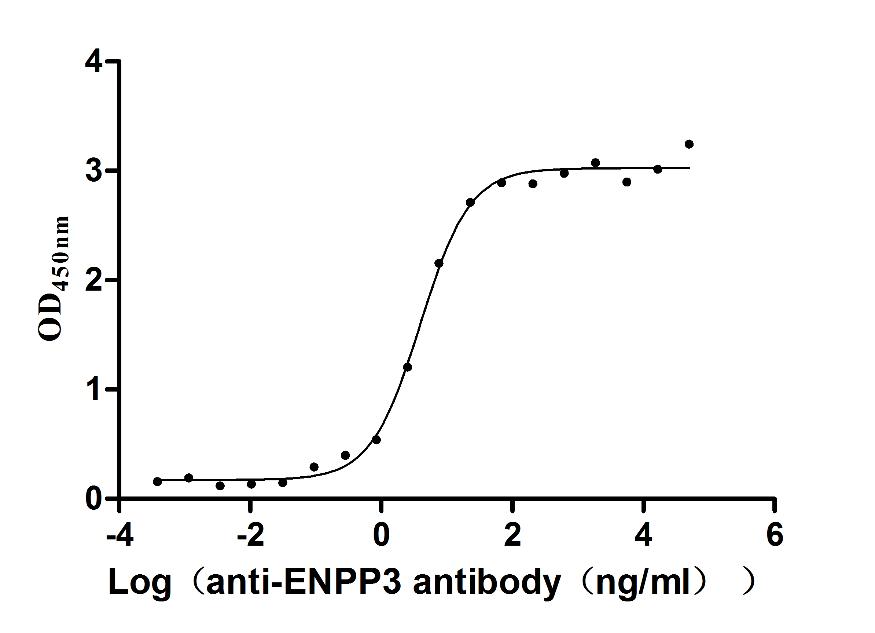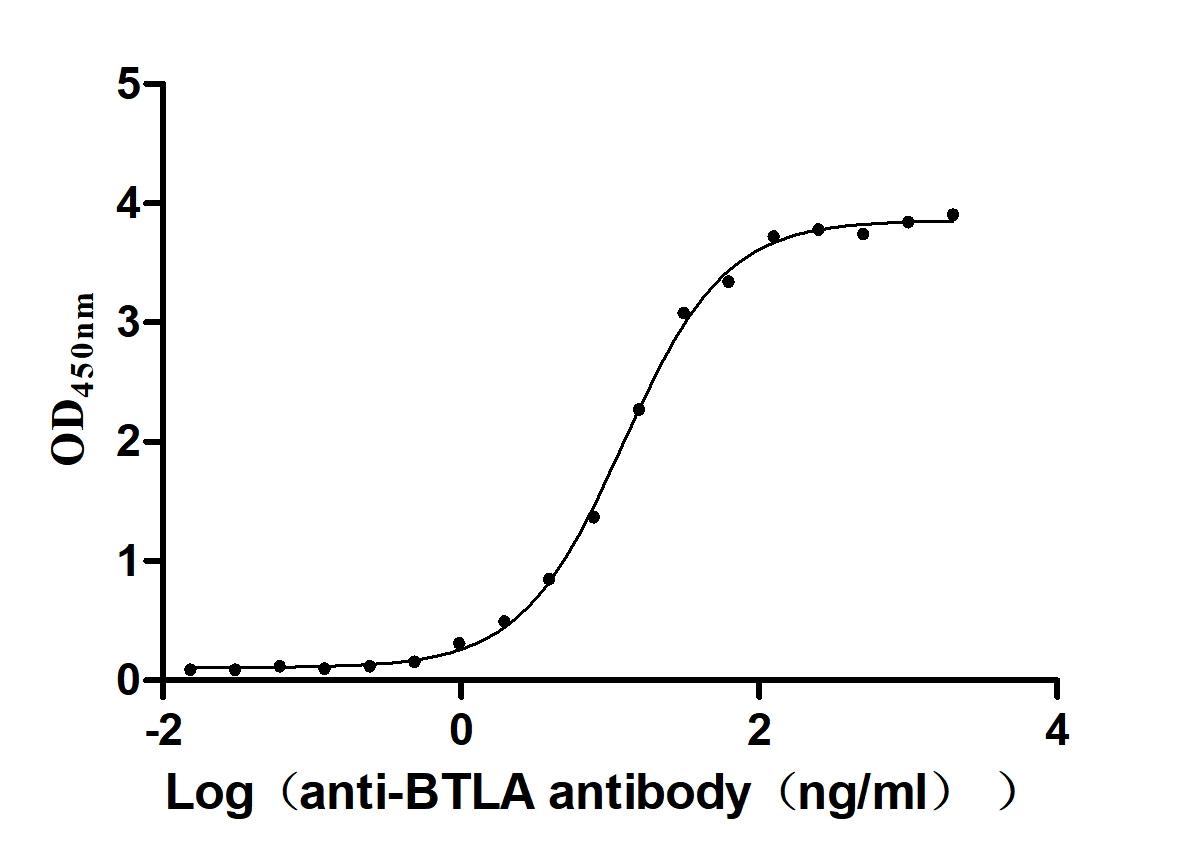Recombinant Mouse E3 ubiquitin-protein ligase RNF8 (Rnf8)
-
中文名称:小鼠Rnf8重组蛋白
-
货号:CSB-YP840827MO
-
规格:
-
来源:Yeast
-
其他:
-
中文名称:小鼠Rnf8重组蛋白
-
货号:CSB-EP840827MO
-
规格:
-
来源:E.coli
-
其他:
-
中文名称:小鼠Rnf8重组蛋白
-
货号:CSB-EP840827MO-B
-
规格:
-
来源:E.coli
-
共轭:Avi-tag Biotinylated
E. coli biotin ligase (BirA) is highly specific in covalently attaching biotin to the 15 amino acid AviTag peptide. This recombinant protein was biotinylated in vivo by AviTag-BirA technology, which method is BriA catalyzes amide linkage between the biotin and the specific lysine of the AviTag.
-
其他:
-
中文名称:小鼠Rnf8重组蛋白
-
货号:CSB-BP840827MO
-
规格:
-
来源:Baculovirus
-
其他:
-
中文名称:小鼠Rnf8重组蛋白
-
货号:CSB-MP840827MO
-
规格:
-
来源:Mammalian cell
-
其他:
产品详情
-
纯度:>85% (SDS-PAGE)
-
基因名:Rnf8
-
Uniprot No.:
-
别名:Rnf8; E3 ubiquitin-protein ligase RNF8; EC 2.3.2.27; ActA-interacting protein 37; AIP37; LaXp180; RING finger protein 8; RING-type E3 ubiquitin transferase RNF8
-
种属:Mus musculus (Mouse)
-
蛋白长度:full length protein
-
表达区域:1-488
-
氨基酸序列MGEPDPLVSG QLAARRSWCL RRLGMDCEWL QLEAGTEVTI GRGLSVTYQL ISKVCPLMIS RSHCVLKQNP EGQWTIMDNK SLNGVWLNRE RLAPLQGYCI RKGDHIQLGV PLESRETAEY EYEVIEEDWE SLAPCLAPKN DQRMEKHKGS RTKRKFSSPG LENLPAEGSS DLRCPLANVA SKPIEPEKLH GKGDASSQSL GCLCPGLTSL KASERAAGPH ACSALPKVLE LSCPKKQKAC RPSASQNSLE LFKVTMSRML KLKTQMQEKQ IAVLNVKRQT RKGSSKKIVR MEKELRNLQS QLYAEQAQQQ ARVEQLEKTF QEEAHYLQGL EKEQGECDLK QQLVQALQEH QALMEELNCS KKDFEKIIQA KNKELEQTKE EKDKVQAQKE EVLSHMNDLL ENELQCIICS EYFIEAVTLN CAHSFCSFCI NEWMKRKVEC PICRKDIESR TNSLVLDNCI SKMVDNLSSD VKERRSVLIR ERRAKRLS
-
蛋白标签:Tag type will be determined during the manufacturing process.
The tag type will be determined during production process. If you have specified tag type, please tell us and we will develop the specified tag preferentially. -
产品提供形式:Lyophilized powder
Note: We will preferentially ship the format that we have in stock, however, if you have any special requirement for the format, please remark your requirement when placing the order, we will prepare according to your demand. -
复溶:We recommend that this vial be briefly centrifuged prior to opening to bring the contents to the bottom. Please reconstitute protein in deionized sterile water to a concentration of 0.1-1.0 mg/mL.We recommend to add 5-50% of glycerol (final concentration) and aliquot for long-term storage at -20℃/-80℃. Our default final concentration of glycerol is 50%. Customers could use it as reference.
-
储存条件:Store at -20°C/-80°C upon receipt, aliquoting is necessary for mutiple use. Avoid repeated freeze-thaw cycles.
-
保质期:The shelf life is related to many factors, storage state, buffer ingredients, storage temperature and the stability of the protein itself.
Generally, the shelf life of liquid form is 6 months at -20°C/-80°C. The shelf life of lyophilized form is 12 months at -20°C/-80°C. -
货期:Delivery time may differ from different purchasing way or location, please kindly consult your local distributors for specific delivery time.Note: All of our proteins are default shipped with normal blue ice packs, if you request to ship with dry ice, please communicate with us in advance and extra fees will be charged.
-
注意事项:Repeated freezing and thawing is not recommended. Store working aliquots at 4°C for up to one week.
-
Datasheet :Please contact us to get it.
靶点详情
-
功能:E3 ubiquitin-protein ligase that plays a key role in DNA damage signaling via 2 distinct roles: by mediating the 'Lys-63'-linked ubiquitination of histones H2A and H2AX and promoting the recruitment of DNA repair proteins at double-strand breaks (DSBs) sites, and by catalyzing 'Lys-48'-linked ubiquitination to remove target proteins from DNA damage sites. Following DNA DSBs, it is recruited to the sites of damage by ATM-phosphorylated MDC1 and catalyzes the 'Lys-63'-linked ubiquitination of histones H2A and H2AX, thereby promoting the formation of TP53BP1 and BRCA1 ionizing radiation-induced foci (IRIF). Also controls the recruitment of UIMC1-BRCC3 (RAP80-BRCC36) and PAXIP1/PTIP to DNA damage sites. Also recruited at DNA interstrand cross-links (ICLs) sites and catalyzes 'Lys-63'-linked ubiquitination of histones H2A and H2AX, leading to recruitment of FAAP20 and Fanconi anemia (FA) complex, followed by interstrand cross-link repair. H2A ubiquitination also mediates the ATM-dependent transcriptional silencing at regions flanking DSBs in cis, a mechanism to avoid collision between transcription and repair intermediates. Promotes the formation of 'Lys-63'-linked polyubiquitin chains via interactions with the specific ubiquitin-conjugating UBE2N/UBC13 and ubiquitinates non-histone substrates such as PCNA. Substrates that are polyubiquitinated at 'Lys-63' are usually not targeted for degradation. Also catalyzes the formation of 'Lys-48'-linked polyubiquitin chains via interaction with the ubiquitin-conjugating UBE2L6/UBCH8, leading to degradation of substrate proteins such as CHEK2, JMJD2A/KDM4A and KU80/XRCC5: it is still unclear how the preference toward 'Lys-48'- versus 'Lys-63'-linked ubiquitination is regulated but it could be due to RNF8 ability to interact with specific E2 specific ligases. For instance, interaction with phosphorylated HERC2 promotes the association between RNF8 and UBE2N/UBC13 and favors the specific formation of 'Lys-63'-linked ubiquitin chains. Promotes non-homologous end joining (NHEJ) by promoting the 'Lys-48'-linked ubiquitination and degradation the of KU80/XRCC5. Following DNA damage, mediates the ubiquitination and degradation of JMJD2A/KDM4A in collaboration with RNF168, leading to unmask H4K20me2 mark and promote the recruitment of TP53BP1 at DNA damage sites. Following DNA damage, mediates the ubiquitination and degradation of POLD4/p12, a subunit of DNA polymerase delta. In the absence of POLD4, DNA polymerase delta complex exhibits higher proofreading activity. In addition to its function in damage signaling, also plays a role in higher-order chromatin structure by mediating extensive chromatin decondensation. Involved in the activation of ATM by promoting histone H2B ubiquitination, which indirectly triggers histone H4 'Lys-16' acetylation (H4K16ac), establishing a chromatin environment that promotes efficient activation of ATM kinase. Required in the testis, where it plays a role in the replacement of histones during spermatogenesis. At uncapped telomeres, promotes the joining of deprotected chromosome ends by inducing H2A ubiquitination and TP53BP1 recruitment, suggesting that it may enhance cancer development by aggravating telomere-induced genome instability in case of telomeric crisis. Promotes the assembly of RAD51 at DNA DSBs in the absence of BRCA1 and TP53BP1 Also involved in class switch recombination in immune system, via its role in regulation of DSBs repair. May be required for proper exit from mitosis after spindle checkpoint activation and may regulate cytokinesis. May play a role in the regulation of RXRA-mediated transcriptional activity. Not involved in RXRA ubiquitination by UBE2E2.
-
基因功能参考文献:
- Knockdown or conditional knockout of RNF8 or UBC13 in rodent cerebellar granule neurons robustly increases the number of parallel fiber presynaptic boutons and functional parallel fiber/Purkinje cell synapses. In contrast to the role of nuclear RNF8 in proliferating cells, RNF8 operates in the cytoplasm in neurons to suppress synapse differentiation. PMID: 29097665
- RNF8-dependent polyubiquitination is required for the establishment of H3K27 acetylation, a marker of active enhancers, while persistent H2AK119ub inhibits establishment of H3K27 acetylation. Following the deposition of H3K27 acetylation, H3K4 dimethylation is established as an active mark on poised promoters. PMID: 29462142
- Structure-guided separation-of-function mutations show that the RNF8 E2 stimulating activity is essential for DSB signaling in mammalian cells and is necessary for downstream recruitment of 53BP1 and BRCA1. PMID: 26903517
- RNF8(-/-) mice exhibit neuronal degeneration and reactive astrocytosis. Neurons from RNF8(-/-) mice appear to be more susceptible to X-ray-induced DNA damage PMID: 26256786
- The identification of RNF8 allows new insights into the integration of the control of p12 degradation by different DNA damage signaling pathways. PMID: 23233665
- RNF8-dependent ubiquitination of histone H2A during meiosis establishes active epigenetic modifications, including dimethylation of H3K4 on the sex chromosomes PMID: 23249736
- A new mechanism of chromatin remodelling-assisted ubiquitylation was shown, which involves cooperation between CHD4 and RNF8 to create a local chromatin environment permissive to the assembly of checkpoint and repair machineries at DNA lesions. PMID: 22531782
- Rnf8 physically interacts with Tpp1 to generate Ubc13-dependent Lys63 polyubiquitin chains that stabilize Tpp1 at telomeres. PMID: 22101936
- RNF8 and Chfr, function together to activate ATM and maintain genomic stability in vivo. PMID: 21706008
- RNF8 deficint mice exhibit increased genomic instability and elevated risks for tumorigenesis indicating that Rnf8 is a novel tumor suppressor. PMID: 20385750
- investigate the role of the ubiquitin ligase RNF8 during spermatogenesis and find that RNF8-deficient mice are proficient in meiotic sex chromosome inactivation but deficient in global nucleosome removal PMID: 20153262
显示更多
收起更多
-
亚细胞定位:Nucleus. Cytoplasm. Midbody. Chromosome, telomere.
-
蛋白家族:RNF8 family
-
数据库链接:
KEGG: mmu:58230
STRING: 10090.ENSMUSP00000024817
UniGene: Mm.305994
Most popular with customers
-
Recombinant Human Nectin-4 (NECTIN4), partial (Active)
Express system: Mammalian cell
Species: Homo sapiens (Human)
-
Recombinant Mouse Tyrosine-protein kinase Mer (Mertk), partial (Active)
Express system: Mammalian cell
Species: Mus musculus (Mouse)
-
Express system: Mammalian cell
Species: Macaca fascicularis (Crab-eating macaque) (Cynomolgus monkey)
-
Recombinant Human Claudin-6 (CLDN6)-VLPs, Fluorescent (Active)
Express system: Mammalian cell
Species: Homo sapiens (Human)
-
Recombinant Human Myosin regulatory light polypeptide 9 (MYL9) (Active)
Express system: Yeast
Species: Homo sapiens (Human)
-
Recombinant Human Myosin regulatory light chain 12A (MYL12A) (Active)
Express system: E.coli
Species: Homo sapiens (Human)
-
Recombinant Human B- and T-lymphocyte attenuator(BTLA), partial (Active)
Express system: Mammalian cell
Species: Homo sapiens (Human)
-
Recombinant Macaca Gastric inhibitory polypeptide receptor(GIPR), partial (Active)
Express system: yeast
Species: Macaca fascicularis (Crab-eating macaque) (Cynomolgus monkey)





f4-AC1.jpg)














